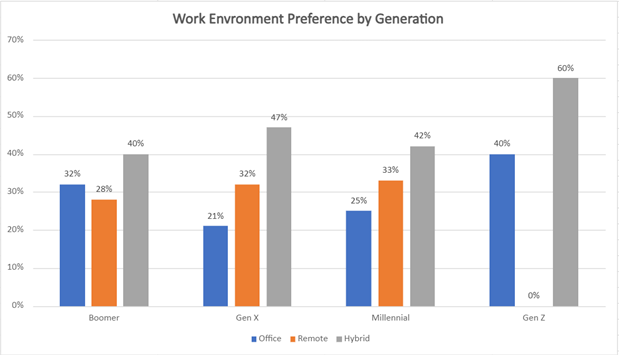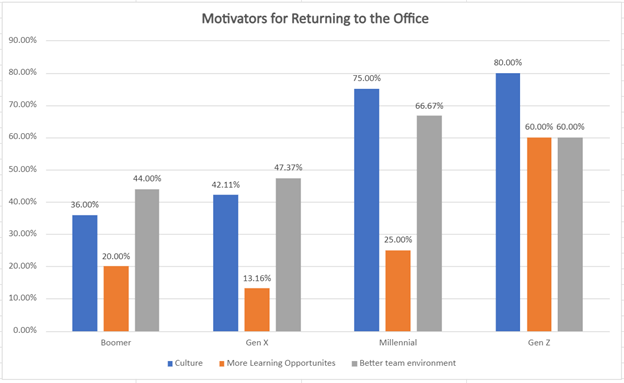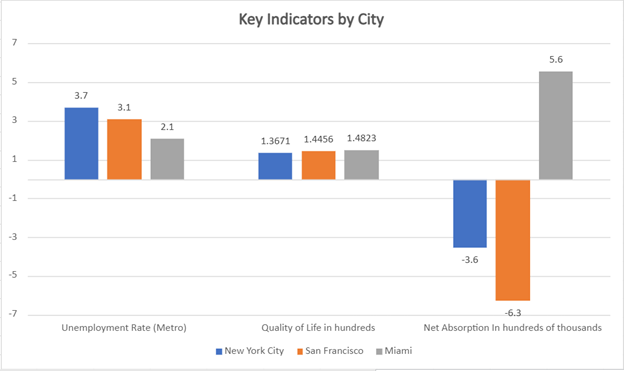Call us for a free quote
Call us for a free quote
(In-depth research and consumer sentiment surveys were critical to building this analysis of workplace attitudes by generation)
In the heart of America’s workforce, a struggle simmers; who is going to “win” the WFH (Work from Home) battle? We have a generation of people who entered the workforce only to be sent home to work from home. Don’t forget that ten years earlier, that generation got sent home without their jobs. Working from home was an Employers choice that kept companies in business and kept employees with an income. Now it’s a battle of Employee / Employer preference; work from home and skip traffic in an unquestionably sterile environment, work in the traditional model, endure traffic and be rewarded by all that comes from the touch and feel of your fellow workforce.
On the one hand, we have Work from Home employees, the majority of whom seem to be Gen X — those who were once committed to the office life, made the long commutes to work through heavy traffic, but have now tasted the convenience of remote work and have grown to love it. They’ve swapped lengthy commutes for the flexibility of setting their schedules, trading in-office meetings for virtual ones, and spending more time with their families. Their professional lives have seeped into their homes, creating a blend that attracts them personally that many have found both productive and enjoyable. Even so, nearly all of what attracts is short-term, shallow considerations that leave out the opportunity and contagion of work and team dynamics. Whether your dining table at home or your conference table at work; when you are missing, it misses you.
Conversely, the more inexperienced workforce, sometimes titled the Millennial and Gen Z cohorts, show an entirely different set of preferences. Although they value work-life balance and the flexibility of a hybrid working experience, they have learned the benefits of a dynamic office environment — the buzz of conversations over cubicles, the spontaneous brainstorming sessions around the coffee machine, and the camaraderie fostered through in-person team-building activities. For them, the office is not just a physical space but a manifestation of the company culture — a culture they deeply want to be a part of.

Source: Attitudinal Survey, Conducted by Seota Digital Marketing, 2023
These divergent attitudes are at odds with each other, threatening to create a “corporate culture storm.” The question now is, how can businesses navigate this brewing tempest and keep their ship steady? Will they need to choose one generation’s preferences over another, or is there a middle ground where everyone’s needs can be met? This conundrum is the new challenge awaiting corporate America in the post-pandemic world. The silver lining may lie in the fact that all generations prefer a hybrid model, meaning that with thoughtful design and good leadership, the middle ground can be realized.
The coronavirus pandemic, in its wake, has left more than just global health concerns. One of its less visible but equally consequential casualties has been the decline of a robust company culture. As teams traded office spaces for their homes, the dynamics of workplace interactions underwent a drastic shift. And while this change brought some undeniable benefits, it also chipped away at the bedrock of any successful organization — its culture.
As per Gallup’s historical data, pre-pandemic, in 2019, a strong company culture was one of the key drivers of employee engagement. Their studies found a direct correlation between a positive, inclusive workplace culture and higher productivity levels, satisfaction, and employee retention. However, the shift to remote work, as necessitated by COVID-19, has challenged this dynamic.
In a remote setup, team cohesion, which was once built on face-to-face interactions and a shared physical environment, became more challenging to maintain. Casual conversations, impromptu brainstorming, and even the shared experience of a coffee break — all these little threads that wove the tapestry of a company culture were severed. This has led to declining team engagement, with many employees feeling disconnected and isolated.
Recent data echoes this sentiment. While a significant portion of Gen X employees (42.11%) agree that a robust company culture is a priority, Millennials and Gen Z express this sentiment even more strongly — at 75% and 80%, respectively. This suggests that the younger workforce, despite being digital natives, still values the personal connections, shared experiences, and sense of community that a physical workspace can provide.

Source: Attitudinal Survey, Conducted by Seota Digital Marketing, 2023
The pandemic, in forcing a shift to remote work, has inadvertently highlighted the importance of a vibrant company culture. As businesses navigate the path to recovery, rebuilding this culture must take center stage in their efforts.
In the wake of COVID-19, the corporate world has experienced an unprecedented shift in office space utilization. As work from home became the norm, once bustling office spaces were left deserted, leading to a steep decline in the net absorption rates, especially in major metro areas such as San Francisco and New York City.
On the surface, this might seem like a problem. After all, unused office spaces represent a significant investment. However, this disruption might also be a golden opportunity — a chance to rethink and reinvent the very concept of a workspace.
Our research proposes an innovative solution to this conundrum — the fusion of work, play, and living. This approach transcends the traditional notion of compartmentalizing one’s life into separate boxes of ‘work’, ‘home’, and ‘leisure’. Instead, it advocates for an integrated space that caters to all these aspects, making for a more holistic lifestyle.
San Francisco and New York City, despite the decline in net absorption rates, offer an interesting case study. These cities have been known for their high quality of life scores, making them an attractive choice for many businesses and professionals. However, the stringent COVID-19 regulations in New York City might have affected its quality of life perception, making it less appealing than the figures suggest.
The city’s response to COVID-19, marked by prolonged periods of strict lockdowns and reduced social interactions, might have had a significant impact on its citizens’ mental and emotional well-being. This could have led to a reassessment of the perceived quality of life, with factors like flexibility, personal freedom, and the ability to maintain social connections gaining more importance.
In this context, the reduced absorption rates might not be a sign of failure but a reflection of changing priorities. As the world of work continues to evolve, it’s clear that the future of office spaces will need to be as dynamic, adaptable, and resilient as the people they house.
One of the most pressing challenges for leaders in the current business landscape is bridging the generational divide within the workforce. This is a complex task – it requires navigating a complex matrix of diverse needs, expectations, and values that differ substantially across generational cohorts. From Gen X’s yearning for flexibility and privacy to the Millennials and Gen Z’s desire for collaborative and culturally-rich work environments, the list is as varied as it demands.
Historically, workspaces have been designed with a ‘one-size-fits-all’ approach, often neglecting the unique needs of different generations. However, research conducted by Deloitte in their 2020 Global Human Capital Trends report suggests that a more tailored approach could lead to higher employee satisfaction and engagement.
According to the report, organizations that consider the specific needs of their multi-generational workforce and design their workspaces accordingly have reported higher levels of productivity and employee satisfaction. The reason is straightforward – when employees feel heard and valued, their engagement and commitment to the organization increase.
Creating such a harmonious workspace isn’t just about culture and design, though. Leaders must also consider the financial implications of these changes. After all, innovative office designs and amenities often come with a price tag. Balancing the investment in workspace improvements with financial sustainability will be a key aspect of this endeavor.
This is where a deep understanding of the workforce becomes invaluable. By understanding what aspects of the work environment are most valued by each generation (as suggested by the data provided earlier), leaders can prioritize their investments to deliver the maximum impact.
In conclusion, bridging the generational gap in the workplace will require both innovative thinking and practical financial planning. Leaders who can navigate this intricate balancing act stand to create a workspace that resonates with their entire workforce, paving the way for a more inclusive, dynamic, and productive organization.
Diving deeper into the dynamics of major metropolitan areas presents a more nuanced picture. Take, for instance, San Francisco. Despite its impressive quality of life score of 144.56, it has seen a stark decline in net absorption, falling by 6,304 (in thousands). Similarly, New York City and Washington, D.C., despite having lower unemployment rates, have also experienced a drop in net absorption.
However, one city is unexpectedly bucking this trend: Miami. This sun-soaked Florida city has recorded a positive net absorption rate of 555.9, even though its quality of life score stands at a relatively even 148.23.

Source: U.S. Bureau of Labor Statistics, Numbeo, and Seota analysis of LRE Solutions data, 2023
At first glance, this might seem paradoxical. But dig a little deeper, and the allure of Miami starts to make sense. In the aftermath of the pandemic, there has been a noticeable shift in people’s values and preferences. While conventional indicators like quality of life scores remain relevant, new factors have become important.
The pandemic, in limiting people’s freedom and social interactions, has sparked a newfound appreciation for personal freedom and a quality lifestyle. This is where Miami shines. With its sun-drenched beaches, thriving social scene, and a state government that prioritized individual liberties even during the height of the pandemic, it offered a sense of normalcy and freedom that was rare during these times.
It’s worth noting that Miami has always been known for its attractive weather and vibrant social life. However, the events of the past few years have amplified these features, turning them into major selling points. The inflow of businesses and professionals from states with stricter COVID-19 regulations is a testament to this.
So, while it’s tempting to rely solely on traditional metrics like quality of life scores and unemployment rates to evaluate a city’s appeal, Miami’s story serves as a reminder of the importance of considering the changing values and preferences of today’s workforce. As we move forward, this nuanced understanding could be crucial in how companies strategize their workspace policies and locations.
As we explore the dynamics of shifting work preferences and their impacts on the corporate landscape, it would be remiss not to spotlight the remarkable growth of Texas, specifically the Dallas-Fort Worth (DFW) and Austin areas.
In recent years, Texas has emerged as an epicenter for both population and business growth. The U.S. Census Bureau reports that the state’s population surged by a staggering 15.9% between 2010 and 2020, marking the highest growth rate of any state in the country1. This trend continued unabated in 2021, with Texas welcoming an additional 310,288 individuals1. The thriving population growth is mirrored by an influx of businesses relocating to Texas. Since 2020, more than 139 companies have chosen to establish their headquarters in the state, 40% of which hailed from California2.
DFW and Austin have emerged as the primary benefactors of this corporate migration, attracting a wide array of industries and injecting a new level of dynamism into the Texan economy. Tesla and Oracle, two tech titans, have planted their flags in Austin, contributing to its burgeoning reputation as the “Silicon Hills”. Meanwhile, DFW has welcomed the likes of Charles Schwab, Caterpillar, Toyota, and McKesson, bolstering its status as a leading business hub.
Looking ahead, Texas is poised to welcome Cacique Foods, Nord Dirvesystems USA, LGMG North America, Portal Innovations, and Greentown Labs, further testifying to its attractiveness as a prime location for businesses.
The growth of Texas, and especially its thriving cities of DFW and Austin, offers an intriguing case study in the evolving landscape of work culture. As corporations navigate the challenges and opportunities presented by the generational divide in work preferences, the experience of these Texan cities may serve as an invaluable guide. Their success demonstrates how robust corporate culture, innovative work environments, and favorable policy environments can help cities adapt and thrive in a rapidly changing world.
This comprehensive study delves into the divergent work preferences among different generations and their profound impact on corporate culture, office space usage, and business migration trends across the United States.
In the brewing “Corporate Culture Storm,” the competing desires of Gen X, Millennials, and Gen Z present unique challenges and opportunities. While Gen X has embraced remote work, younger generations seek a vibrant, community-focused office environment. COVID-19’s impact on robust company culture further complicates this generational divide. Despite the growing acceptance of remote work, Millennials and Gen Z are calling for an enhanced corporate culture.
The office space conundrum, catalyzed by the pandemic, is reshaping workspace strategies, with companies increasingly exploring integrated work-play-live environments. Major cities, including San Francisco and New York City, have experienced significant declines in office space absorption, despite high quality of life scores. This trend could be indicative of the generational shift in work preferences and urban living conditions.
Nevertheless, cities like Miami and Texas’s metropolitan areas, DFW and Austin, have shown that resilience and growth are still possible amidst these challenging times. Texas, with its incredible population and business growth, showcases the potential for cities to attract businesses with robust corporate culture, innovative work environments, and favorable policy environments.
In conclusion, the generational divide presents an exciting opportunity to reimagine the work environment and reinvent corporate culture. As we navigate this shift, the collaboration between policymakers, corporate leaders, real estate owners, office furniture manufacturers, and the workforce will play a crucial role in shaping our future work environment.